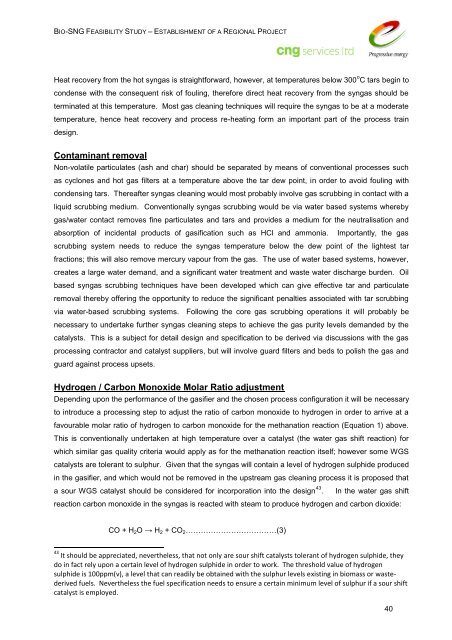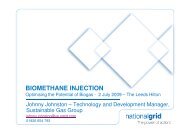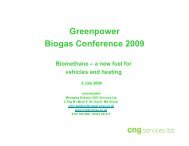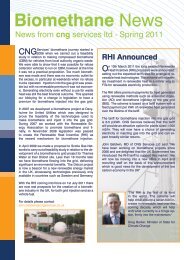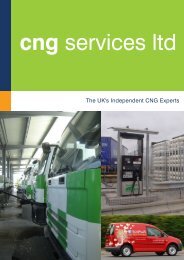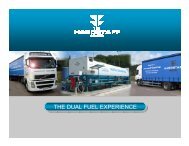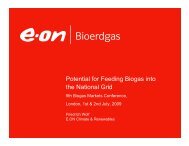Bio-SNG - CNG Services
Bio-SNG - CNG Services
Bio-SNG - CNG Services
Create successful ePaper yourself
Turn your PDF publications into a flip-book with our unique Google optimized e-Paper software.
BIO-<strong>SNG</strong> FEASIBILITY STUDY – ESTABLISHMENT OF A REGIONAL PROJECTHeat recovery from the hot syngas is straightforward, however, at temperatures below 300 o C tars begin tocondense with the consequent risk of fouling, therefore direct heat recovery from the syngas should beterminated at this temperature. Most gas cleaning techniques will require the syngas to be at a moderatetemperature, hence heat recovery and process re-heating form an important part of the process traindesign.Contaminant removalNon-volatile particulates (ash and char) should be separated by means of conventional processes suchas cyclones and hot gas filters at a temperature above the tar dew point, in order to avoid fouling withcondensing tars. Thereafter syngas cleaning would most probably involve gas scrubbing in contact with aliquid scrubbing medium. Conventionally syngas scrubbing would be via water based systems wherebygas/water contact removes fine particulates and tars and provides a medium for the neutralisation andabsorption of incidental products of gasification such as HCl and ammonia.Importantly, the gasscrubbing system needs to reduce the syngas temperature below the dew point of the lightest tarfractions; this will also remove mercury vapour from the gas. The use of water based systems, however,creates a large water demand, and a significant water treatment and waste water discharge burden. Oilbased syngas scrubbing techniques have been developed which can give effective tar and particulateremoval thereby offering the opportunity to reduce the significant penalties associated with tar scrubbingvia water-based scrubbing systems. Following the core gas scrubbing operations it will probably benecessary to undertake further syngas cleaning steps to achieve the gas purity levels demanded by thecatalysts. This is a subject for detail design and specification to be derived via discussions with the gasprocessing contractor and catalyst suppliers, but will involve guard filters and beds to polish the gas andguard against process upsets.Hydrogen / Carbon Monoxide Molar Ratio adjustmentDepending upon the performance of the gasifier and the chosen process configuration it will be necessaryto introduce a processing step to adjust the ratio of carbon monoxide to hydrogen in order to arrive at afavourable molar ratio of hydrogen to carbon monoxide for the methanation reaction (Equation 1) above.This is conventionally undertaken at high temperature over a catalyst (the water gas shift reaction) forwhich similar gas quality criteria would apply as for the methanation reaction itself; however some WGScatalysts are tolerant to sulphur. Given that the syngas will contain a level of hydrogen sulphide producedin the gasifier, and which would not be removed in the upstream gas cleaning process it is proposed thata sour WGS catalyst should be considered for incorporation into the design 43 . In the water gas shiftreaction carbon monoxide in the syngas is reacted with steam to produce hydrogen and carbon dioxide:CO + H 2 O → H 2 + CO 2 ………………………………(3)43 It should be appreciated, nevertheless, that not only are sour shift catalysts tolerant of hydrogen sulphide, theydo in fact rely upon a certain level of hydrogen sulphide in order to work. The threshold value of hydrogensulphide is 100ppm(v), a level that can readily be obtained with the sulphur levels existing in biomass or wastederivedfuels. Nevertheless the fuel specification needs to ensure a certain minimum level of sulphur if a sour shiftcatalyst is employed.40


